- Home
- Introduction
- 1. Design rights
- 1.1. Design rights: overview
- 1.2. What a design right protects
- 1.3. Why protect a design?
- 1.4. How designs are protected in Australia?
- 2. Application for registration
- 2.1. Application for registration: overview
- 2.2. Registration process
- 2.3. Submitting an application
- 2.4. Minimum filing requirements
- 2.5. Who is entitled to be a registered owner?
- 2.6. Types of applications (s 22)
- 2.7. Request for registration
- 2.8. Further designs
- 3. Fees
- 3.1. Fees: overview
- 3.2. Application fees
- 3.3. Renewal fees
- 3.4. Examination fees
- 3.5. Hearing fees
- 3.6. Fees for extensions of time
- 3.7. Refunds
- Production test Designs
- 4. Formalities assessment
- 4.1. Formalities assessment: overview
- 4.2. The ‘Formalities check’ and ‘Formal requirements’
- 4.3. Formalities notices
- 5. Applicant details
- 5.1. Applicant name: overview
- 5.1.1. Is the applicant a person?
- 5.1.2. Individual (Australian and overseas, including joint owners)
- 5.1.3. Australian company (Pty Ltd, Ltd)
- 5.1.4. Strata company, owners corporation, body corporate etc
- 5.1.5. Government entity
- 5.1.6. Incorporated association
- 5.1.7. Overseas entity (AG, S.r.L etc)
- 5.1.8. Several applicant names, multiple designs
- 5.1.9. Joint owner names with ABN
- 5.1.10. Partnership
- 5.1.11. Trust/trustee
- 5.1.12. Business names and 'trading as'
- 5.1.13. Applicant name and design owner
- 5.2. Applicant address
- 6. Representations
- 6.1. Representations: overview
- 6.2. General requirements
- 6.3. Formal compliance
- 6.4. Product
- 6.5. Consistency
- 6.6. Text
- 6.7. Common designs
- 6.8. Drawings
- 6.9. Photographs
- 6.10. Specimens or 3D models
- 6.11. Different views
- 6.12. Environmental views
- 6.13 Pairs and mirror images
- 7. Classification
- 7.1. Classification: overview
- 7.2. Classification systems
- 7.3. Finding the right class
- 7.4. Cases of doubt
- 7.5. More than one possible classification
- 7.6. Multiple products or designs
- 8. Examination and certification
- 8.1. Examination and certification: overview
- 8.2. Examination and certification processes
- 8.3. Requesting examination
- 8.4. Third party initiated examinations
- 8.5. Concurrent requests for examination
- 8.6. Expedited examination
- 8.7. Material provided by a third party
- 8.8. Relevant material that must be considered
- 8.9. Time frame for completion of examination and last-minute responses
- 8.10. Withdrawal of request for examination
- 8.11. Notice of intention to certify
- 8.12. Requests for examination after certification
- 8.13. Further examination reports
- 8.14. Revocation
- 8.15. Examination hearings
- 8.16. Examination on Registrar's initiative
- 9. Identifying the design
- 9.1. Identifying the design: overview
- 9.2. Overall appearance
- 9.3. Visual features
- 9.4. Variable visual features
- 9.5. What cannot be a visual feature
- 10. Product
- 10.1. Product: overview
- 10.2. Identifying the product
- 10.3. Things that are not products
- 10.4. Things that are not different products
- 10.5. Product name
- 10.6. Manufactured or handmade
- 10.7. Component part of a complex product
- 10.8. Assembled set or kit
- 10.9. Indefinite dimensions
- 10.10. Examples - things that are / are not products
- 11. Excluded designs
- 11.1. Excluded designs: overview
- 11.2. Priority date of excluded designs
- 11.3. Extensions of time
- 11.4. Amendments
- 11.5. Registration/publication requests
- 12. Section 43 refusal to register
- 12.1. Section 43 refusal to register: overview
- 12.2. Medals
- 12.3. Anzac
- 12.4. Currency
- 12.5. Scandalous content
- 12.6. Arms, flags, emblems etc.
- 12.7. Olympic symbols
- 12.8. Integrated circuits
- 13. Assessing newness and distinctiveness
- 13.1. Assessing newness and distinctiveness: overview
- 13.2. Product name and intended use
- 13.3. Identifying the product
- 13.4. Test for newness
- 13.5. Test for distinctiveness
- 13.6. Substantially similar in overall impression
- 13.7. How the design is displayed
- 13.8. Other visual features
- 13.9. Searching
- 14. Section 19 requirements for distinctiveness
- 14.1. Section 19 requirements for distinctiveness: overview
- 14.2. Similarities and differences
- 14.3. State of development of the prior art base
- 14.4. Statement of newness and distinctiveness
- 14.5. Amount, quality and importance
- 14.6. Freedom of the creator of the design to innovate
- 14.7. Familiar person / Informed user
- 15. Statement of newness and distinctiveness
- 15.1. Statement of newness and distinctiveness: overview
- 15.2. Formalities assessment of the SoND
- 15.3. Amendments to the SoND
- 15.4. Using the SoND to assess distinctiveness
- 16. Standard of the familiar person / informed user
- 16.1. Standard of the familiar person / informed user: overview
- 16.2. Identifying the familiar person / informed user
- 16.3. Declarations about the familiar person / informed user
- 16.4. Familiarity with the product
- 16.5. References to European and UK decisions
- 16.6. Familiar person’s / informed user’s knowledge base versus prior art base
- 17. Prior art base
- 17.1. Prior art base: overview
- 17.2 Publicly used in Australia
- 17.3. Published in a document within or outside of Australia
- 17.4. Trade marks and patents as citations
- 17.5. Establishing the publication date
- 17.6. Designs disclosed in applications
- 18. Prior publication or use exceptions
- 18.1. Prior publication or use exceptions: overview
- 18.2. Exhibitions
- 18.3. Unauthorised disclosures
- 18.4. Disclosure to government
- 18.5. Copyright
- 18.6. Grace Period
- Annex A - An example of a grace period declaration
- 19. Priority date
- 19.1. Priority date: overview
- 19.2. Convention application
- 19.3. Multiple bases for priority
- 19.4. Plural designs
- 19.5. When priority must be asserted
- 19.6. Excluded designs
- 19.7. Converted applications
- 19.8. Applications by an entitled person
- 20. Convention priority
- 20.1. Convention priority: overview
- 20.2. Convention countries
- 20.3. Time limit to claim convention priority
- 20.4. Assessing convention priority claims
- 20.5. Convention priority for excluded designs and applications that include more than one design
- 20.6. Basic application
- 20.7. Requesting the basic application
- 20.8. Relevance of the basic application to examination
- 21. Satisfied
- 21.1. Satisfied: overview
- 21.2. Meaning of ‘satisfied’
- 21.3. ‘Satisfied’ as to prior art base
- 21.4. Reasonable doubt, balance of probabilities and uncertainty
- 21.5. ‘Not satisfied’
- 22. Amendments
- 22.1. Amendments: overview
- 22.2. Amending an application
- 22.3. Amending a registration
- 22.4. Inclusion of matter not in substance disclosed
- 22.5. Increasing the scope of the design registration
- 22.6. Other types of amendments
- 23. Extensions of time
- 23.1. Extensions of time: overview
- 23.2. Legal principles
- 23.3. Error or omission by the Registrar
- 23.4. Error or omission by the customer
- 23.5. Circumstances beyond the customer’s control
- 23.6. Registrar’s discretion
- 23.7. Protection for third parties
- 23.8. Period of extension
- 23.9. Extensions process
- 23.10. Advertisement
- 23.11. Request from an unrecorded new owner
- 23.12. Extension of the convention priority period
- 24. Assignments (and other interests)
- 24.1. Assignments and other interests: overview
- 24.2. Recording changes of ownership
- 24.3. Possible complications
- 24.4. Bankruptcy and winding up
- 24.5. Registering other interests
- 25. Ownership disputes
- 25.1. Ownership disputes: overview
- 25.2. Disputes between joint applicants
- 25.3. Disputes where a non-applicant claims ownership
- 25.4. Disputes where some designs have been registered or published
- 25.5. Disputes about recording a change of ownership before registration
- 25.6. Typical situations where ownership disputes arise
- 25.7. Revocation after an ownership dispute
- 26. Production of documents under s 61(1)
- 26.1. Production of documents under s 61(1): overview
- 26.2. Powers of the courts
- 26.3. Powers of the Registrar
- 26.4. Precedent
- 26.5. Who access is granted to
- 26.6. Access in ownership disputes
- 26.7. Where inspection can take place
- 26.8. Right of lien
- 26.9. Draft undertaking for access
- 27. Publication and file access
- 27.1. Publication and file access: overview
- 27.2. Designs not publicly available
- 27.3. Legal exceptions
- 27.4. Freedom of information
- 27.5. Prohibition orders
- 28. Hearings
- 28.1. Hearings: overview
- 28.2. Filing evidence
- 28.3. Disputes over whether the design was new and distinctive at the priority date
- 28.4. Interface with court proceedings
- 29. Glossary
- 30. Citation index
- 31. Keyword index
- 32. Classification listings
- Class Heading Summary
- Class 01 Foodstuffs
- Class 02 Articles of clothing and haberdashery
- Class 03 Travel goods, cases, parasols and personal belongings not elsewhere specified
- Class 04 Brushware
- Class 05 Textile piecegoods, artificial and natural sheet material
- Class 06 Furnishing
- Class 07 Household goods not elsewhere specified
- Class 08 Tools and hardware
- Class 09 Packages and containers for the transport or handling of goods
- Class 10 Clocks and watches and other measuring instruments, checking and signalling instruments
- Class 11 Articles of adornment
- Class 12 Means of transport or hoisting
- Class 13 Equipment for production, distribution or transformation of energy
- Class 14 Recording, communication or information retrieval equipment
- Class 15 Machines not elsewhere specified
- Class 16 Photographic, cameras, cinematographic and optical apparatus
- Class 17 Musical instruments
- Class 18 Printing and office machinery
- Class 19 Stationery and office equipment, artists and teaching materials
- Class 20 Sales and advertising equipment, signs
- Class 21 Games, toys, tents and sporting goods
- Class 22 Arms, pyrotechnic articles, articles for hunting, fishing and pest killing
- Class 23 Fluid distribution equipment, sanitary, heating, ventilation and air conditioning equipment, solid fuel
- Class 24 Medical and laboratory equipment
- Class 25 Building units and construction elements
- Class 26 Lighting apparatus
- Class 27 Tobacco and smokers supplies
- Class 28 Pharmaceutical and cosmetic products, toilet articles and apparatus
- Class 29 Devices and equipment against fire hazards, for accident prevention and rescue
- Class 30 Articles for the care and handling of animals
- Class 31 Machines and appliances for preparing food or drink, not elsewhere specified
- Class 32 Graphic symbols and logos, surface patterns, ornamentation
- 33. Designs (Formal Requirements for Designs Documents) Instrument 2022
22.5. Amendments: Increasing the scope of the design registration
In addition to not altering the scope of the design by the inclusion of matter not in substance originally disclosed, amendments under s 66 have the additional requirement that they ‘must not be such as to… increase the scope of the design registration’. This is to be understood in the context of s 66 being limited to addressing issues of newness, distinctiveness, and s 43 refusals (s 65(2)).
When deciding whether an amendment would increase the scope of a registration, the question to be asked is:
‘Would the amendment make anything an infringement which would not have been an infringement before the amendment?’ (the ‘Distillers Test’: The Distillers Co Ltd’s Application (1953) 70 RPC 221 at 223).’
The ‘Distillers Test’ assesses scope by considering the effect of an amendment on third parties – that is, whether the amendment could lead to a third party infringing the owner’s rights when the pre-amendment registration would not have had this effect.
The examiner assessing the amendment does not need to identify a specific known product that would be an infringement. They only need to be able to imagine a product that would not infringe pre-amendment but would infringe post-amendment.
In applying this test, it is important to recognise that the criteria for infringement utilises the test for distinctiveness (s 71). Distinctiveness is based on an assessment of overall impression (s 16(2)). An amendment that does not affect the overall impression of the design cannot change what constitutes an infringement. Consequently, the criterion to be applied is:
1. Would the amendment change the overall impression of the design?
2. If it does, could that change make something an infringement that would not have been an infringement before the amendment?
Amendments that do not increase the scope of the design registration
- amending a representation to change how the design is shown – without changing the detail of the design. For example, replacing plan views with isometric views (or vice versa).
- an amendment to the generic features of a product (in dotted line) that does not affect the scope of the product bearing the design, or affect the overall appearance of the product that arises as the result of the visual features (in solid line), would be allowable.
Example
Scenario A
The application originally contained both of the following controllers:
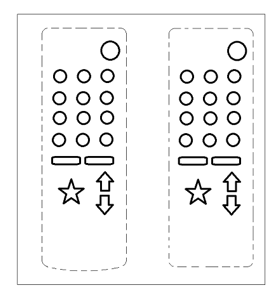
The following shows the registered controller design (left hand side) and what the owner seeks amendment to (right hand side):
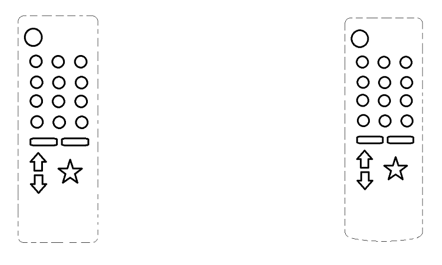
The original application contains exactly what the owner wants to amend the registered controller design to. It’s likely that anything that would infringe the amended version of the design would likely be included in the original registration’s scope. Both requirements of s 66(6) are satisfied. Caution must be exercised here because there are other scenarios involving dotted lines which would not be acceptable. Whether Scenario A would overcome issues stemming from prior art is another matter - see Scenario B.
Amendments that increase the scope of the design registration
Examples
Scenario B
Registration for a cup:
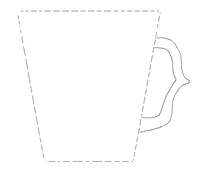
The application originally contained both of the following:
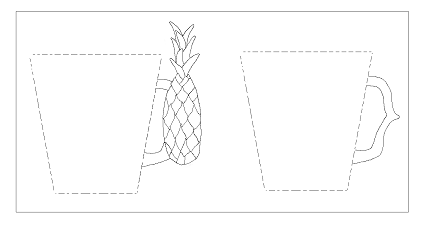
The owner would not be able to amend the registration to the following, as actioning this amendment would increase the scope of the design registration. This is because designs that are currently not identical or substantially similar in overall impression to the design registration would be if the amendment occurred. Other cup designs that include a pineapple handle in an identical or substantially similar way would be infringing on the design registration (where previously they would not).
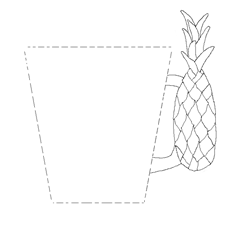
Scenario C (Invacare Corporation [2013] ADO 4)
An owner requested to change the product name ‘Wheelchair chassis’ to ‘Front frame of wheelchair chassis’. The representations showed a wheelchair chassis but did not identify a front frame. The reference to ‘front frame’ would increase the scope of the design registration by referring to a feature that is not in the representations.
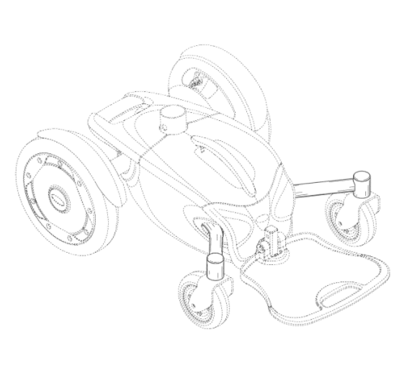
Amended Reasons
| Amended Reason | Date Amended |
|---|---|
Amendments review. |
|
Amendments review. |
